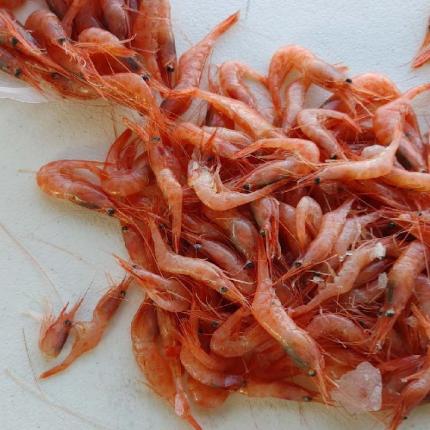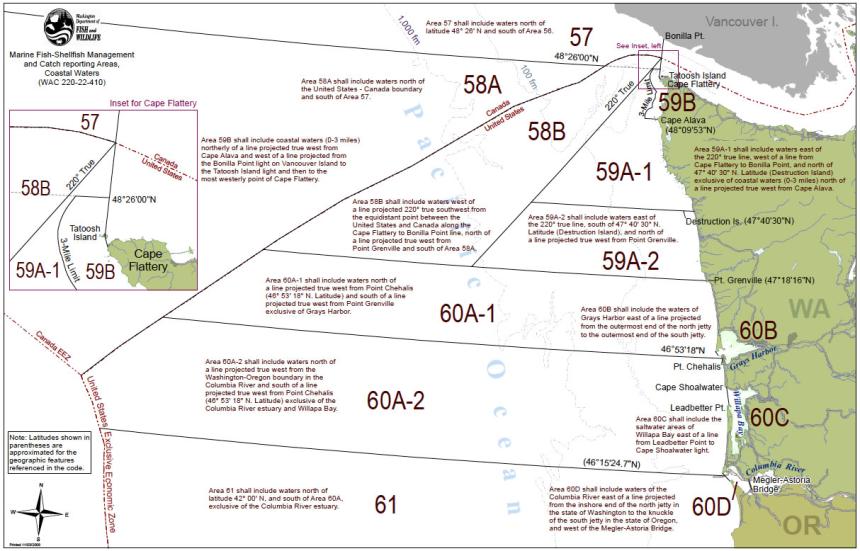Read our 2025 Washington Pink Shrimp Fishery Newsletter for information on the upcoming season and a recap of last season.
Commercial shrimp fishing off Washington dates from the late 1950s. Although other species of shrimp are present, only pink shrimp (Pandalus jordani) has been abundant enough to support a large, long-term commercial fishery.

Beginning off Grays Harbor in 1956, the inception of mechanical peelers and growing consumer demand for “cocktail” shrimp spurred fishery development. Catches in 1958 exceeded 6.5 million pounds but declined to less than 2 million pounds annually through the 1960s. In subsequent decades, landings fluctuated in response to shrimp abundance and market forces.
Washington coastal shrimp fishing activity is split between two ports: Westport and Ilwaco, with processors located at each.
Pink shrimp are caught by trawl gear; the majority of active vessels in the Washington fleet are double-rigged with semi-pelagic, fine-meshed shrimp nets.
Fishing occurs during daylight hours reflecting the behavior of ocean pink shrimp which exhibit a vertical diurnal migration, moving to the bottom during daylight hours and ascending to feed at night. The typical commercial trip ranges from 3 to 6 days including transit to and from the fishing grounds. Shorter trips can occur when fishing is especially productive.
Stock status
Recent pink shrimp abundance off the coast of Washington has not been specifically determined, but there are strong indications it is stable. The well-documented pink shrimp fishery in the Oregon waters adjacent to Washington does provide some insight into the strength of Washington’s stock. As much as one-third of the shrimp landed into Oregon ports come from waters off Washington State and these landings are included in Oregon’s extensive sampling and logbook evaluation program. By many measures, the Washington and northern Oregon stocks are considered contiguous.
We know that studies in Oregon of trawl fishing’s effects on the overall stocks of pink shrimp show that the environment is the driver of juvenile shrimp recruitment. There is little evidence that harvest reduces recruitment. Ocean shrimp stocks remain resilient to both naturally caused variations in distribution and fishery impacts according to spawning stock and recruitment indices recently updated by Oregon fishery managers. This is proven out by simply reviewing the total ocean shrimp landings, which in 2014 exceeded the previous record high by 100 percent with 30.6 million pounds, recorded. The previous high landing was in 1993 with 15.5 million pounds and the 25-year average is 8.6 million pounds landed annually.
Management
The Washington pink shrimp fishery is state-managed, although it is also subject to federal restrictions for groundfish catch and essential fish habitat (EFH) through the Pacific Fishery Management Council Groundfish Fishery Management Plan (PFMC 2014). State pink shrimp trawl fishery licenses issued by Washington, Oregon, and California regulate where a vessel may land. Along the Washington coast, the pink shrimp fishery operates in federal waters (3-200 miles); most commercial gears, including trawl, are prohibited inside Washington state waters (0-3 miles).
In 1982, the states of Washington, Oregon, and California established a common season and a maximum count per pound regulation to minimize regulatory conflicts. The fishing season is fixed in permanent regulation, opening and closing on April 1 and Oct. 31, respectively. The maximum count per pound is 160.
In 1994, the Washington limited entry (LE) license program established 143 licenses. As of 2014, the number of LE licenses stood at 83. Licenses must be renewed annually, but do not need to be fished actively to remain valid; the decline is attributed to LE license owners electing not to renew.
For more information, see the Washington Coastal Pink Shrimp Fishery Management Plan.
Licensing and permit requirements
A commercial fisher is legally required to possess two documents to deliver ocean pink shrimp into a Washington state port.
- A limited entry ocean pink shrimp trawl license (RCW77.65.390).
- There are a fixed number of these limited entry licenses and the Department does not issue new licenses. An annual license fee must be paid before December 31 (of the year for which the permit is being sought) by existing licenses holders. Licenses not renewed are retired. (RCW 77.60.030).
- Ocean pink shrimp delivery licenses are transferable. Anyone interested in entering the fishery must purchase an existing license from the current owner at a price agreed to by the parties’ involved. The Department does not play a role in such transactions, however there is an additional license transfer fee paid to the Department at the time of the transfer (RCW 77.65.020).
- An ocean pink shrimp permit (WAC 220-340-500).
- Permits are issued annually at the time the limited entry ocean pink shrimp trawl license is renewed. There is no additional fee.
- The permit requirements can vary by season.
Catch area map

Notices and letters to industry
The following are annual letters, industry notices, and general information about the Washington coastal commercial pink shrimp fishery.
Annual newsletters
Annual letters
- March 2020 meeting announcement (PDF)
- March 2015 (PDF)
- April 2014 (PDF)
- March 2012 (PDF)
- March 2011 (PDF)
- March 2010 (PDF)
- December 2009 (PDF)
- November 2009 (PDF)
- January 2008 (PDF)
- March 2007 (PDF)
General Information
- 2017 fishery management plan
- Oregon Department of Fish and Wildlife Newsletter “Annual Pink Shrimp Review”
Logbook instructions
- Fill out the top of each page used completely. Start a new page when you begin a new trip.
For each line, completely fill out information about each tow even if there was no catch.
Date – Write the date of the tow.
Tow – Write the tow number you are on for the day. Start a new count each day.
Depth – Write the depth you are fishing when you set the tow and when you end the tow (in fathoms).
Time – Write the time that you set the tow and end the tow. Use military time (24 hour clock).
Latitude/Longitude – Write your GPS location when you set and end the tow.
– Latitude – Use Degrees and Decimal Minutes. (DD° MM.MMM')
– Longitude – Use Degrees and Decimal Minutes. (DDD° MM.MMM')
Total Catch – Write your estimate for the total catch of each tow. This includes everything that comes up in the net. Record zero only if there is absolutely no catch.
Haul Dumped – If you dumped a tow, write ‘Y’. Otherwise write ‘N’.
Discard – Estimate the total lbs of discarded bycatch for the tow. If it is less than 1 lb, write ‘< 1’.
Comments – Write any comment about each tow you might have. (i.e. the reason a tow was dumped)
Optional Skipper Use – If you want to keep track of your catch in your logbook throughout each trip, use this area.- Mail completed log pages to:
WDFW Coastal Pink Shrimp Management,
48 Devonshire Rd,
Montesano WA 98563.
Please submit your logs monthly. If you need a new logbook, call the WDFW Region 6 office: 360-249-4628.
Rules and regulations
WAC 220-340-500: Commercial ocean pink shrimp trawl fishery -- Coastal waters.
WAC 220-340-030: Shellfish harvest logs - Commercial
WAC 220-301-050: Marine Fish-Shellfish Management and Catch reporting Areas, Coastal Waters